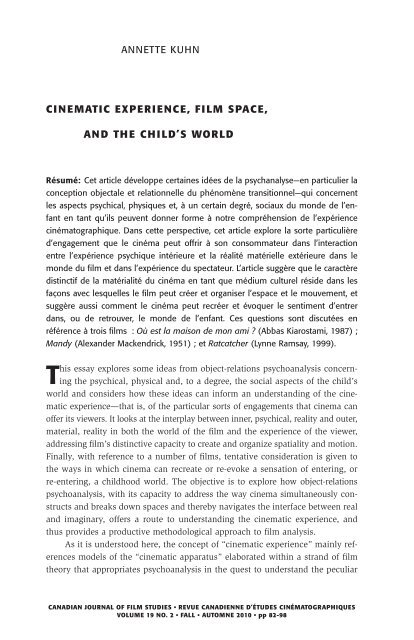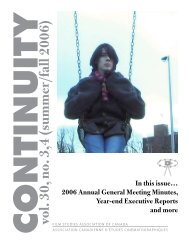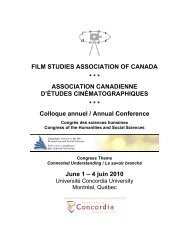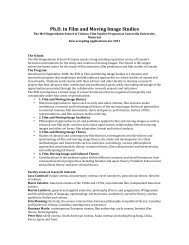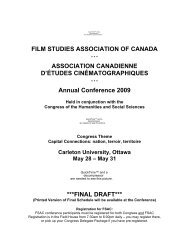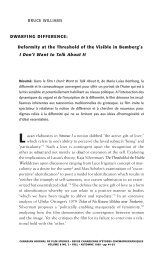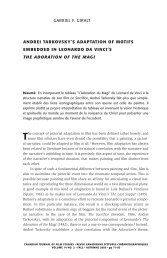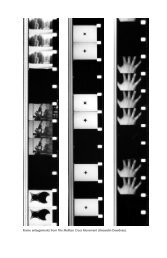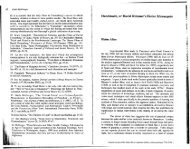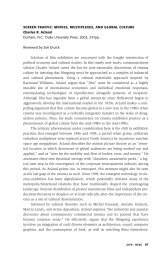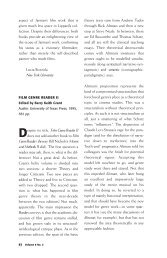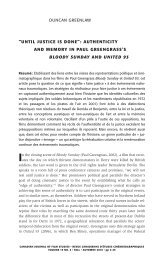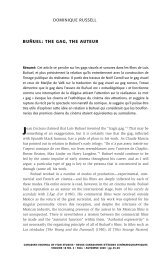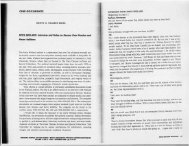cinematic experience, film space, and the child's world - Film Studies
cinematic experience, film space, and the child's world - Film Studies
cinematic experience, film space, and the child's world - Film Studies
You also want an ePaper? Increase the reach of your titles
YUMPU automatically turns print PDFs into web optimized ePapers that Google loves.
005.Kuhn.19.2:005.Kuhn. 11/18/10 5:32 PM Page 82<br />
ANNETTE KUHN<br />
CI N EMATIC EXPERI ENCE, FI LM SPACE,<br />
AN D TH E CH I LD’S WORLD<br />
Résumé: Cet article développe certaines idées de la psychanalyse—en particulier la<br />
conception objectale et relationnelle du phénomène transitionnel—qui concernent<br />
les aspects psychical, physiques et, à un certain degré, sociaux du monde de l’enfant<br />
en tant qu’ils peuvent donner forme à notre compréhension de l’expérience<br />
cinématographique. Dans cette perspective, cet article explore la sorte particulière<br />
d’engagement que le cinéma peut offrir à son consommateur dans l’interaction<br />
entre l’expérience psychique intérieure et la réalité matérielle extérieure dans le<br />
monde du <strong>film</strong> et dans l’expérience du spectateur. L’article suggère que le caractère<br />
distinctif de la matérialité du cinéma en tant que médium culturel réside dans les<br />
façons avec lesquelles le <strong>film</strong> peut créer et organiser l’e<strong>space</strong> et le mouvement, et<br />
suggère aussi comment le cinéma peut recréer et évoquer le sentiment d’entrer<br />
dans, ou de retrouver, le monde de l’enfant. Ces questions sont discutées en<br />
référence à trois <strong>film</strong>s : Où est la maison de mon ami ? (Abbas Kiarostami, 1987) ;<br />
M<strong>and</strong>y (Alex<strong>and</strong>er Mackendrick, 1951) ; et Ratcatcher (Lynne Ramsay, 1999).<br />
This essay explores some ideas from object-relations psychoanalysis concerning<br />
<strong>the</strong> psychical, physical <strong>and</strong>, to a degree, <strong>the</strong> social aspects of <strong>the</strong> child’s<br />
<strong>world</strong> <strong>and</strong> considers how <strong>the</strong>se ideas can inform an underst<strong>and</strong>ing of <strong>the</strong> <strong>cinematic</strong><br />
<strong>experience</strong>—that is, of <strong>the</strong> particular sorts of engagements that cinema can<br />
offer its viewers. It looks at <strong>the</strong> interplay between inner, psychical, reality <strong>and</strong> outer,<br />
material, reality in both <strong>the</strong> <strong>world</strong> of <strong>the</strong> <strong>film</strong> <strong>and</strong> <strong>the</strong> <strong>experience</strong> of <strong>the</strong> viewer,<br />
addressing <strong>film</strong>’s distinctive capacity to create <strong>and</strong> organize spatiality <strong>and</strong> motion.<br />
Finally, with reference to a number of <strong>film</strong>s, tentative consideration is given to<br />
<strong>the</strong> ways in which cinema can recreate or re-evoke a sensation of entering, or<br />
re-entering, a childhood <strong>world</strong>. The objective is to explore how object-relations<br />
psychoanalysis, with its capacity to address <strong>the</strong> way cinema simultaneously constructs<br />
<strong>and</strong> breaks down <strong>space</strong>s <strong>and</strong> <strong>the</strong>reby navigates <strong>the</strong> interface between real<br />
<strong>and</strong> imaginary, offers a route to underst<strong>and</strong>ing <strong>the</strong> <strong>cinematic</strong> <strong>experience</strong>, <strong>and</strong><br />
thus provides a productive methodological approach to <strong>film</strong> analysis.<br />
As it is understood here, <strong>the</strong> concept of “<strong>cinematic</strong> <strong>experience</strong>” mainly references<br />
models of <strong>the</strong> “<strong>cinematic</strong> apparatus” elaborated within a str<strong>and</strong> of <strong>film</strong><br />
<strong>the</strong>ory that appropriates psychoanalysis in <strong>the</strong> quest to underst<strong>and</strong> <strong>the</strong> peculiar<br />
CANADIAN JOURNAL OF FILM STUDIES • REVUE CANADIENNE D’ÉTUDES CINÉMATOGRAPHIQUES<br />
VOLUME 19 NO. 2 • FALL • AUTOMNE 2010 • pp 82-98
005.Kuhn.19.2:005.Kuhn. 11/18/10 5:32 PM Page 83<br />
psychodynamics, or <strong>the</strong> metapsychology, involved in <strong>the</strong> viewer’s encounter<br />
with cinema. The psychoanalytic ideas most commonly drawn on in <strong>the</strong>orizing<br />
<strong>the</strong> <strong>cinematic</strong> apparatus have been instinct or drive-based <strong>and</strong> have emphasized<br />
<strong>the</strong> centrality of scopophilia, or <strong>the</strong> drive to pleasurable looking. In consequence,<br />
such work has been focused largely on issues around <strong>the</strong> instrumentality of<br />
vision <strong>and</strong> spectatorship in <strong>the</strong> <strong>cinematic</strong> <strong>experience</strong>. In this approach, based<br />
ultimately on Freud’s thinking about <strong>the</strong> drives, unconscious processes are paramount.<br />
1 Here, however, a variant of object-relations psychoanalysis is drawn on,<br />
in which attachment is emphasized <strong>and</strong> in which <strong>the</strong> Unconscious assumes less<br />
importance in mental life. This model can shed light both on <strong>the</strong> <strong>world</strong> constructed<br />
by <strong>the</strong> <strong>film</strong> <strong>and</strong> on <strong>the</strong> <strong>experience</strong> of <strong>the</strong> viewer, whilst at <strong>the</strong> same time<br />
taking into account <strong>the</strong> materiality of cinema as a cultural medium whose distinctiveness<br />
lies in <strong>the</strong> ways it can create <strong>and</strong> organize spatiality <strong>and</strong> motion. It<br />
also presents a grounded, even an empirically testable, conceptualization of <strong>the</strong><br />
interplay between inner mental reality <strong>and</strong> outer material reality in <strong>the</strong> <strong>cinematic</strong><br />
<strong>experience</strong>, whilst opening up fresh strategies for reading <strong>film</strong>s.<br />
I<br />
Central to <strong>the</strong> object-relations approach pursued here are <strong>the</strong> concepts of transitional<br />
object, transitional phenomena <strong>and</strong> transitional process, introduced <strong>and</strong><br />
developed from <strong>the</strong> 1950s onwards by Donald Winnicott, a paediatrician <strong>and</strong> foremost<br />
representative of <strong>the</strong> British Independent tradition in object-relations psychoanalysis.<br />
Transitional objects, now common currency in thinking about infant<br />
<strong>and</strong> child development, are <strong>the</strong> first “not-me” possessions of infants <strong>and</strong> young<br />
children (a blanket, an old piece of cloth, a teddy). While transitional objects are<br />
exactly that—objects, things—<strong>the</strong> point about <strong>the</strong>m is that <strong>the</strong>y are pressed into<br />
<strong>the</strong> service of <strong>the</strong> child’s inner <strong>world</strong>. They belong, that is, to <strong>the</strong> child’s fantasy<br />
<strong>world</strong> while at <strong>the</strong> same time having a physical existence in <strong>the</strong> outer <strong>world</strong> of<br />
material objects. In terms of <strong>the</strong> child’s mental <strong>space</strong> <strong>and</strong> object-<strong>world</strong>, <strong>the</strong>n, <strong>the</strong><br />
transitional object is at one <strong>and</strong> <strong>the</strong> same time part of itself <strong>and</strong> not itself. Such<br />
objects inhabit an intermediate position between fantasy <strong>and</strong> reality, <strong>and</strong> this<br />
intermediate zone, according to Winnicott, is <strong>the</strong> place of imagination.<br />
Broadly speaking, this object-relations approach embodies several key<br />
attributes. Above all, perhaps, <strong>the</strong> central issue is not simply <strong>the</strong> objects <strong>the</strong>mselves<br />
(imaginary, “real,” or more likely a mix of <strong>the</strong> two) but equally, or more,<br />
significantly <strong>the</strong> <strong>space</strong>s between objects. Spaces are paradoxical, in that <strong>the</strong>y<br />
have <strong>the</strong> capacity at once to connect objects <strong>and</strong> to keep <strong>the</strong>m apart. Winnicott<br />
makes great play in his writings with terms that connote “betweenness,” terms like<br />
“transitional <strong>space</strong>” <strong>and</strong> “intermediate zone,” suggesting that transitional phenomena<br />
inhabit, <strong>and</strong> operate in, <strong>the</strong>se “<strong>space</strong>s between.” This sets up a highly fluid<br />
<strong>and</strong> dynamic model of <strong>the</strong> psyche <strong>and</strong> its formation <strong>and</strong> operation, one which<br />
also allows for <strong>the</strong> conceptualisation of a non-fixed <strong>and</strong> non-universalising<br />
CINEMATIC EXPERIENCE, FILM SPACE, AND THE CHILD’S WORLD 83
005.Kuhn.19.2:005.Kuhn. 11/18/10 5:32 PM Page 84<br />
relationship between <strong>the</strong> subject, <strong>the</strong> psyche <strong>and</strong> <strong>the</strong> external <strong>world</strong>. For<br />
Winnicott, this relationship is at <strong>the</strong> core of what it is to be human: “no human<br />
being is free from <strong>the</strong> strain of relating outer <strong>and</strong> inner reality,” he says, <strong>and</strong> transitional<br />
objects <strong>and</strong> transitional phenomena help us negotiate that relationship. 2<br />
Transitional <strong>space</strong> can usefully be visualised through a mental image of a bridge<br />
spanning a river. The bridge allows people to cross from one side to <strong>the</strong> o<strong>the</strong>r,<br />
whilst <strong>the</strong> banks of <strong>the</strong> river remain apart from each o<strong>the</strong>r. This spatial metaphor<br />
aptly brings out an idea <strong>and</strong> a feeling of movement between <strong>and</strong> through <strong>space</strong>s.<br />
A sort of psychical back <strong>and</strong> forth, ebb <strong>and</strong> flow, in o<strong>the</strong>r words, marks <strong>the</strong> subject’s<br />
engagement with transitional phenomena. It is perhaps worth noting that this is<br />
not necessarily a straightforward process: it has its vicissitudes.<br />
Winnicott links transitional objects <strong>and</strong> associated behaviours in infants<br />
<strong>and</strong> young children with processes of separation <strong>and</strong> individuation. In <strong>the</strong> first<br />
place, <strong>the</strong> separation is from <strong>the</strong> mo<strong>the</strong>r/caregiver; but it will, in due course,<br />
extend also to separation from mo<strong>the</strong>r-associated place-objects, notably <strong>the</strong><br />
home. One of Winnicott’s apparently simple—but in fact ra<strong>the</strong>r profound—dicta<br />
is “Home is where we start from.” 3 To this, as we shall see, might be added: “<strong>and</strong><br />
come back to.” On <strong>the</strong> subject of separation/individuation, <strong>the</strong> object-relations<br />
psychoanalyst Anni Bergman has drawn attention to <strong>the</strong> infant’s “incessant coming<br />
<strong>and</strong> going, leaving <strong>and</strong> finding mo<strong>the</strong>r,” 4 as it tests <strong>the</strong> reliability <strong>and</strong> durability<br />
of its objects <strong>and</strong> learns about <strong>the</strong>ir continuing existence independently of itself.<br />
This is an outward, bodily expression of <strong>the</strong> “back <strong>and</strong> forth” quality of <strong>the</strong>se<br />
psychical engagements, played out in real <strong>space</strong> (for example, <strong>the</strong> child will<br />
repeatedly leave <strong>the</strong> room <strong>and</strong> keep coming back to check that mo<strong>the</strong>r is still<br />
<strong>the</strong>re). In this process of making <strong>the</strong> self separate from, as well as joined to, <strong>the</strong><br />
outside <strong>world</strong>, suggests Bergman, “<strong>the</strong> inner <strong>world</strong> of thought <strong>and</strong> fantasy allows<br />
for <strong>the</strong> symbolic representation of <strong>experience</strong>s in <strong>space</strong>.” 5 In o<strong>the</strong>r words, in this<br />
attachment-based object-relations model, it is through separation processes that<br />
individuals learn to symbolise—to imagine <strong>and</strong> to create.<br />
For Winnicott, transitional objects are associated in <strong>the</strong> first instance with<br />
childhood <strong>and</strong> with developmental processes, in particular with playing. He<br />
observed that <strong>the</strong> activity of playing is characterised by preoccupation <strong>and</strong> nearwithdrawal<br />
on <strong>the</strong> part of <strong>the</strong> child. The play <strong>space</strong>, he argues, “is not inner<br />
psychical reality: it is outside <strong>the</strong> individual but it is not <strong>the</strong> external <strong>world</strong>.” 6 It<br />
is precisely a <strong>space</strong> between <strong>the</strong> two. Playing involves <strong>the</strong> body; <strong>and</strong> while playing,<br />
<strong>the</strong> child manipulates external phenomena, investing <strong>the</strong>m with “dream meaning<br />
<strong>and</strong> feeling.” 7 Thus, <strong>the</strong> child at play, as it inhabits <strong>and</strong> uses its body in real<br />
<strong>space</strong>, is also inside an imaginal, fantasy <strong>space</strong>.<br />
The playing state of withdrawn preoccupation, <strong>and</strong> <strong>the</strong> idea that an interaction<br />
between real <strong>and</strong> imaginary <strong>world</strong>s is at work, has much in common with<br />
Gaston Bachelard’s characterisation of reverie. In a thought, if not in words, that<br />
could have come from Winnicott, Bachelard says of reverie that “It gives <strong>the</strong> I a<br />
84 ANNETTE KUHN
005.Kuhn.19.2:005.Kuhn. 11/18/10 5:32 PM Page 85<br />
non-I which belongs to <strong>the</strong> I: my non-I.” 8 Bachelard is referring to what he calls<br />
poetic reverie, a state in which <strong>the</strong> relaxed <strong>and</strong> self-realized adult may immerse<br />
herself in a kind of oneiric state that has much in common with <strong>the</strong> daydreaming<br />
of his solitary child <strong>and</strong> Winnicott’s playing child. Or, as Winnicott puts it, “There<br />
is a direct development from transitional phenomena to playing, <strong>and</strong> from playing<br />
to shared playing, <strong>and</strong> from this to cultural <strong>experience</strong>s.” 9 That is to say, <strong>the</strong>re is<br />
a continuity between <strong>the</strong> transitional processes of childhood <strong>and</strong> <strong>the</strong>ir associated<br />
mental states <strong>and</strong> <strong>the</strong> way that as adults we may <strong>experience</strong>, or engage with, cultural<br />
objects <strong>and</strong> activities—painting, poetry, <strong>and</strong> so on.<br />
As already noted, <strong>the</strong> idea of <strong>space</strong>s, especially “<strong>space</strong>s-between,” is central<br />
to Winnicott’s model of object relations. Spaces, of course, are contained by <strong>the</strong>ir<br />
boundaries, just as boundaries are defined by <strong>the</strong> <strong>space</strong>s <strong>the</strong>y contain; Winnicott<br />
was fully aware of <strong>the</strong> psychical <strong>and</strong> developmental significance of <strong>the</strong> interplay<br />
between boundary <strong>and</strong> <strong>space</strong>, arguing that while humans need boundaries, both<br />
physical <strong>and</strong> psychological, <strong>the</strong>se can become over-containing <strong>and</strong> even oppressive.<br />
The infant <strong>and</strong> <strong>the</strong> child’s passage from dependence to separation to individuation<br />
involves an engagement with boundaries that is full of potential pitfalls: on <strong>the</strong><br />
one h<strong>and</strong> <strong>the</strong> risk of containment <strong>and</strong> compliance, of becoming engulfed by <strong>the</strong><br />
“insult” of <strong>the</strong> reality principle; on <strong>the</strong> o<strong>the</strong>r, that of boundlessness, <strong>and</strong> failure to<br />
engage with outer reality. “The struggle between our impulses <strong>and</strong> a sense of<br />
security…is an eternal struggle,” says Winnicott; <strong>and</strong> it is acted out in our<br />
engagements with transitional phenomena, in childhood <strong>and</strong> beyond. 10 It is <strong>the</strong><br />
character of an individual’s engagement with boundaries <strong>and</strong> <strong>space</strong>s in <strong>the</strong><br />
object-<strong>world</strong> that shapes his or her own ways of dealing with <strong>the</strong> unfamiliar <strong>and</strong><br />
<strong>the</strong> new throughout life.<br />
It has already been suggested that home is particularly significant in <strong>the</strong><br />
separation/individuation process. In this object-relations model, home figures as<br />
both <strong>space</strong> <strong>and</strong> object, <strong>and</strong> is a (or indeed <strong>the</strong>) prime site for <strong>the</strong> negotiation of<br />
inner <strong>and</strong> outer <strong>world</strong>s. It is <strong>the</strong>refore worth considering how “home”—as it<br />
figures in <strong>the</strong> <strong>space</strong> that surrounds <strong>the</strong> child <strong>and</strong> “separates <strong>and</strong> unites him with<br />
his mo<strong>the</strong>r” 11 —can figure in transitional phenomena. In <strong>the</strong> process of individuation,<br />
<strong>the</strong> <strong>space</strong> of <strong>the</strong> earliest home becomes part of <strong>the</strong> “not-I,” while also<br />
maintaining its resonance as an internal object. As such, home may be <strong>experience</strong>d<br />
in a range of different ways. As Anni Bergman asks:<br />
The <strong>space</strong> surrounding <strong>the</strong> self is not part of <strong>the</strong> self, but it is not part of<br />
o<strong>the</strong>rs…How far does it extend? With whom <strong>and</strong> under what circumstances<br />
can it be shared? When is it friendly <strong>and</strong> protective, <strong>and</strong> when frightening<br />
<strong>and</strong> vast? When does it isolate, when does it connect? 12<br />
To <strong>the</strong>se questions might be added: Where <strong>and</strong> what are <strong>the</strong> boundaries of<br />
“home,” <strong>and</strong> how is <strong>the</strong> subject to relate to <strong>the</strong>m? What is <strong>the</strong> nature, psycho-<br />
CINEMATIC EXPERIENCE, FILM SPACE, AND THE CHILD’S WORLD 85
005.Kuhn.19.2:005.Kuhn. 11/18/10 5:32 PM Page 86<br />
dynamically, of <strong>the</strong> <strong>space</strong> inside <strong>the</strong> home <strong>and</strong> <strong>the</strong> <strong>space</strong> that surrounds <strong>the</strong><br />
home? In <strong>the</strong> object-<strong>world</strong>, how do comforting, enclosed, “mo<strong>the</strong>r-<strong>space</strong>s” figure<br />
in relation to <strong>space</strong>s that are open or exposed, unfamiliar or even frightening?<br />
These different <strong>space</strong>s function, <strong>and</strong> accrue <strong>the</strong>ir psychical investments, in relation<br />
to each o<strong>the</strong>r; <strong>and</strong> <strong>the</strong> point at which enclosed <strong>and</strong> open <strong>space</strong>s meet can acquire<br />
particularly significant psychical weight. These liminal <strong>space</strong>s (“<strong>space</strong>s of transition<br />
between a mo<strong>the</strong>r-<strong>world</strong> <strong>and</strong> a <strong>world</strong> outside”) 13 can become highly<br />
invested, serving as a bridge between <strong>the</strong> familiar <strong>and</strong> <strong>the</strong> unfamiliar, facilitating<br />
<strong>the</strong> child’s acceptance of <strong>the</strong> new.<br />
Liminal <strong>space</strong>s in <strong>and</strong> around <strong>the</strong> home—windows <strong>and</strong> doors, especially—<br />
may exert an attraction in that <strong>the</strong>y allow <strong>the</strong> child to be in enclosed <strong>and</strong> open<br />
<strong>space</strong>s at <strong>the</strong> same time, at once secure <strong>and</strong> “going exploring”; so she might<br />
hover in <strong>the</strong> doorway between two rooms, say, or be fascinated by <strong>the</strong> view from<br />
a window, or play endlessly with doors <strong>and</strong> door h<strong>and</strong>les. Then, “as <strong>the</strong> sense of<br />
being a separate individual develops, so does <strong>the</strong> need for a variety of <strong>space</strong>s…,<br />
<strong>and</strong> so does a proprietary feeling toward such <strong>space</strong>s.” 14 Because of <strong>the</strong>ir developmental<br />
significance, <strong>the</strong> home’s edges—its boundaries <strong>and</strong> its borders<br />
between inner <strong>and</strong> outer, its thresholds—may lastingly assume special emotional<br />
<strong>and</strong> imaginational weight. Negotiation of <strong>the</strong> home’s enclosed <strong>and</strong> open <strong>space</strong>s,<br />
its thresholds <strong>and</strong> its adjoining <strong>space</strong>s, is among <strong>the</strong> most important developmental<br />
tasks of childhood. It is perhaps no coincidence that so many children’s<br />
games involve a zone of security that <strong>the</strong> players call “home.” These games are<br />
about leaving a secure (home) zone <strong>and</strong> rendering oneself vulnerable to being<br />
caught <strong>and</strong> dismissed from <strong>the</strong> game, or “out”: blind man’s bluff, hide <strong>and</strong> seek,<br />
tag, musical chairs <strong>and</strong> even perhaps <strong>the</strong>ir video-game equivalents. Outside<br />
“home” lies a dangerous open <strong>space</strong>—real, virtual or imaginary—that has to be<br />
conquered with skill <strong>and</strong> daring in <strong>the</strong> game. The game’s attraction lies in this<br />
risky <strong>and</strong> thrilling venture into open, potentially insecure, terrain. But—<strong>and</strong> this<br />
is crucial—<strong>the</strong> game only works because players can leave <strong>the</strong> zone of security in<br />
<strong>the</strong> confident hope that <strong>the</strong>y can always return to it. In <strong>the</strong> words of <strong>the</strong> psychoanalyst<br />
Michael Balint: “All thrills entail <strong>the</strong> leaving <strong>and</strong> rejoining of security”. 15<br />
In an evocative turn of phrase, Balint calls <strong>the</strong> child’s zone of risk “friendly<br />
expanses.” Important here, once again, is what connects <strong>and</strong> separates home<br />
<strong>and</strong> friendly expanses—<strong>the</strong> boundary between <strong>the</strong> two, <strong>the</strong> threshold. But just as<br />
essential to <strong>the</strong> game is movement across <strong>the</strong> <strong>space</strong> between: <strong>the</strong> transitional<br />
<strong>space</strong>, <strong>the</strong> threshold that joins <strong>and</strong> separates “home” <strong>and</strong> open <strong>space</strong>. The repeated<br />
passage back <strong>and</strong> forth from safety to danger <strong>and</strong> back again is precisely <strong>the</strong><br />
point of <strong>the</strong> game. In this passage, “home” may be where we start from, but it is<br />
also <strong>the</strong> place we know we can return to. In object-relations terms, this repeated<br />
back <strong>and</strong> forth motion is analogous to, <strong>and</strong> indeed rehearses in safety, <strong>the</strong> child’s<br />
processes of separation from mo<strong>the</strong>r, from “home.” As part of its growing up, <strong>the</strong><br />
child will explore, <strong>and</strong> push at <strong>the</strong> boundaries of, <strong>the</strong> zone of risk, facing <strong>the</strong><br />
86 ANNETTE KUHN
005.Kuhn.19.2:005.Kuhn. 11/18/10 5:32 PM Page 87<br />
dangers of increasingly challenging open, non-home, expanses. The point is that<br />
<strong>the</strong> expanses are “friendly” only to <strong>the</strong> extent that “home” can be relied upon as<br />
a refuge. Conversely, <strong>the</strong> object-<strong>world</strong> <strong>and</strong> its <strong>space</strong>s may be marked by discontinuity<br />
<strong>and</strong> dislocation.<br />
At this point, <strong>the</strong> concerns of object-relations psychoanalysis intersect with<br />
those of geographers inquiring into children’s use of, <strong>and</strong> relation to, <strong>the</strong>ir spatial<br />
environment, as that environment claims <strong>the</strong> child’s attention, engagement <strong>and</strong><br />
participation. These geographers share with psychoanalysts <strong>the</strong> aspiration to<br />
underst<strong>and</strong> <strong>the</strong>se matters from <strong>the</strong> inside, from <strong>the</strong> child’s point of view. 16 In<br />
1979, a pioneering ethnographic study of children’s <strong>experience</strong> of place was<br />
conducted among children <strong>and</strong> adults living in a small New Engl<strong>and</strong> town. This<br />
produced many insights about <strong>the</strong> children’s <strong>world</strong> that still retain resonance <strong>and</strong><br />
conviction today. What <strong>the</strong> investigator, Roger Hart, uncovered was an active,<br />
vibrant, independent childhood culture organized around <strong>the</strong> exploration <strong>and</strong><br />
use of a wide range of non-home <strong>space</strong>s. In particular, he discovered that children’s<br />
permitted spatial ranges are a product of negotiation between <strong>the</strong>mselves <strong>and</strong> <strong>the</strong>ir<br />
parents, <strong>and</strong> that <strong>the</strong>y vary according to <strong>the</strong> child’s age <strong>and</strong> gender. “Home,” Hart<br />
also found, is always <strong>the</strong> starting point of children’s mental maps; <strong>and</strong> <strong>the</strong>se<br />
maps chart “path networks” that are independent of adults’ routes. For children,<br />
<strong>the</strong> prime object is not to get from A to B: “<strong>the</strong> journey itself is frequently <strong>the</strong><br />
purpose of <strong>the</strong> trip,” he says, 17 <strong>and</strong> children use many shortcuts (often illegal)<br />
<strong>and</strong> “ritual routes.” Children also favour slightly challenging places, like woods,<br />
ponds or quarries, as well as “risky” short cuts: places, that is, that <strong>the</strong>y may fear<br />
to some degree. Ano<strong>the</strong>r significant finding was that children’s <strong>space</strong> has to be<br />
accessible “through <strong>the</strong>ir own locomotion before <strong>the</strong>y can mentally represent<br />
spatial relations to it.” 18 In o<strong>the</strong>r words, only those <strong>space</strong>s that can be accessed<br />
on foot, or by bicycle, figure on children’s mental maps.<br />
Two key points emerge from this discussion. Firstly, a sense of liminality is<br />
apparent in <strong>the</strong> psychical investment in boundaries, borders, edges <strong>and</strong> thresholds,<br />
<strong>and</strong> in <strong>the</strong> contiguity or <strong>the</strong> dislocation of <strong>space</strong>s as <strong>the</strong>y are negotiated in<br />
transitional processes. It is present as well in <strong>the</strong> sense of betweenness, <strong>and</strong> of <strong>the</strong><br />
junction, separation <strong>and</strong> bridging of <strong>space</strong>s, in <strong>the</strong> object-<strong>world</strong>. Secondly, <strong>the</strong><br />
metaphor of bridging also signals <strong>the</strong> resonance in this model of motion, or kinesis,<br />
of a specific kind: movement back <strong>and</strong> forth. This dynamic <strong>and</strong> fluid objectrelations<br />
model, with its account of mental life as organized around attachment,<br />
spatiality <strong>and</strong> motion, offers illuminating insights into <strong>the</strong> workings of symbolization,<br />
imagination <strong>and</strong> creativity, <strong>and</strong> sheds light on <strong>the</strong> aetiology <strong>and</strong> <strong>the</strong> character<br />
of our mental engagements when we are playing, or in a state of reverie, or<br />
enjoying various kinds of cultural or aes<strong>the</strong>tic <strong>experience</strong>. 19<br />
II<br />
When it comes to grasping <strong>the</strong> distinctive qualities of <strong>the</strong> <strong>cinematic</strong> <strong>experience</strong>,<br />
CINEMATIC EXPERIENCE, FILM SPACE, AND THE CHILD’S WORLD 87
005.Kuhn.19.2:005.Kuhn. 11/18/10 5:32 PM Page 88<br />
this object-relations model is suggestive in a number of ways. It promises a freshly<br />
productive approach to a metapsychological underst<strong>and</strong>ing of our engagement<br />
with cinema <strong>and</strong> <strong>film</strong>s, an approach that offers a fuller explanation <strong>and</strong> a more<br />
profound underst<strong>and</strong>ing of <strong>the</strong> processes at work in <strong>the</strong> <strong>cinematic</strong> <strong>experience</strong><br />
than <strong>the</strong> drive- <strong>and</strong> vision-based models of mainstream psychoanalytic <strong>film</strong> <strong>the</strong>ory.<br />
20 The distinctive quality of <strong>the</strong> <strong>cinematic</strong> <strong>experience</strong> has much to do with<br />
<strong>the</strong> ways in which <strong>film</strong>s create <strong>and</strong> organize <strong>world</strong>s on <strong>the</strong> cinema screen, within<br />
<strong>the</strong> boundaries of <strong>the</strong> <strong>film</strong> frame, in terms of both spatiality <strong>and</strong> motion. Because<br />
of this, as a form of cultural <strong>experience</strong> cinema seems peculiarly capable of<br />
accessing <strong>and</strong> expressing <strong>the</strong> liminality <strong>and</strong> <strong>the</strong> kinesic attributes of transitional<br />
phenomena. In o<strong>the</strong>r words, cinema’s organization of <strong>space</strong>, <strong>and</strong> its play of stasis<br />
<strong>and</strong> movement, within <strong>the</strong> boundaries of <strong>the</strong> <strong>film</strong> frame can echo <strong>the</strong>se phenomena,<br />
making <strong>the</strong> medium capable, through its matters of expression, of evoking<br />
highly invested objects <strong>and</strong> psychical processes relating to transitional processes,<br />
especially those <strong>space</strong>s <strong>and</strong> <strong>the</strong> passages which have to do with <strong>the</strong> task of negotiating<br />
inner <strong>and</strong> outer <strong>world</strong>s.<br />
This contention can readily be tested against <strong>the</strong> nuts <strong>and</strong> bolts of <strong>film</strong><br />
“grammar.” Put simply, <strong>film</strong> creates <strong>space</strong>s that are imaginary but which at <strong>the</strong><br />
same time allude to a, or <strong>the</strong>, real <strong>world</strong>: in this respect, <strong>film</strong> <strong>space</strong> is like <strong>the</strong><br />
mental <strong>space</strong> of playing <strong>and</strong> cultural <strong>experience</strong>. Through editing, <strong>film</strong>ic <strong>space</strong>s<br />
are joined toge<strong>the</strong>r—sutured—in such a way as to create a map, in varying degrees<br />
intelligible, of <strong>the</strong> spatial organization of <strong>the</strong> <strong>film</strong>’s imaginary-<strong>and</strong>-yet-real <strong>world</strong>.<br />
Separating as well as joining toge<strong>the</strong>r <strong>the</strong> <strong>film</strong>’s <strong>space</strong>s, <strong>film</strong> editing bridges <strong>the</strong><br />
gaps between <strong>the</strong>se <strong>space</strong>s, sometimes effectively suturing <strong>the</strong>m (as, for example,<br />
in <strong>the</strong> point-of-view shot) <strong>and</strong> sometimes separating or dislocating <strong>the</strong>m (as in<br />
parallel montage, which sutures time but dislocates <strong>space</strong>). Fur<strong>the</strong>rmore, <strong>film</strong><br />
produces motion not only between shots <strong>and</strong> across <strong>space</strong>s but also (through<br />
mobile framing) within shots as well.<br />
Particularly revealing in this regard are <strong>film</strong>s that push <strong>the</strong> medium’s elective<br />
affinity with <strong>the</strong> psychical processes associated with transitional phenomena<br />
a step fur<strong>the</strong>r by figuring <strong>the</strong> originary settings of <strong>the</strong>se phenomena in <strong>the</strong>ir very<br />
mise en scène. These are <strong>film</strong>s in which “home,” thresholds, or “friendly expanses”<br />
are featured in such a way as to chart, through <strong>the</strong> <strong>cinematic</strong> organization of<br />
<strong>space</strong>, liminality <strong>and</strong> motion, <strong>the</strong> very topoi of separation/individuation, absorption/<br />
reverie, imaginal/real, that characterize <strong>the</strong> transitional phenomena of <strong>the</strong> child’s<br />
<strong>world</strong> <strong>and</strong> carry <strong>the</strong>m over into <strong>the</strong> realms of adult cultural <strong>experience</strong>. That is,<br />
<strong>the</strong>y re-create <strong>the</strong> <strong>space</strong>s of <strong>the</strong> child’s <strong>world</strong> as it were from <strong>the</strong> inside, inviting<br />
<strong>the</strong> adult viewer to re-enter <strong>the</strong>m.<br />
III<br />
Besides casting light on <strong>the</strong> distinctive attributes of <strong>the</strong> <strong>cinematic</strong> <strong>experience</strong> as<br />
a variant of cultural <strong>experience</strong>, attention to <strong>the</strong>se issues opens up fresh ways of<br />
88 ANNETTE KUHN
005.Kuhn.19.2:005.Kuhn. 11/18/10 5:32 PM Page 89<br />
approaching <strong>the</strong> interpretation of individual <strong>film</strong>s <strong>and</strong> groups of <strong>film</strong>s, including<br />
<strong>film</strong>s in which childhood or children figure centrally. Three such <strong>film</strong>s are Where<br />
Is <strong>the</strong> Friend’s Home? (Abbas Kiarostami, 1987); M<strong>and</strong>y (Alex<strong>and</strong>er Mackendrick,<br />
1951); <strong>and</strong> Ratcatcher (Lynne Ramsay, 1999), <strong>and</strong> <strong>the</strong>y are very different from<br />
each o<strong>the</strong>r in era, provenance, style, setting <strong>and</strong> content. Where is <strong>the</strong> Friend’s<br />
Home?, Kiarostami’s first feature-length <strong>film</strong>, is set in rural Iran <strong>and</strong> unfolds with<br />
<strong>the</strong> compositional precision, lingering takes <strong>and</strong> dedramatization that was to<br />
become <strong>the</strong> <strong>film</strong>maker’s hallmark; <strong>the</strong> post-World War II Ealing Studios drama<br />
M<strong>and</strong>y, on <strong>the</strong> o<strong>the</strong>r h<strong>and</strong>, is organised much more closely along <strong>the</strong> economical<br />
lines of <strong>the</strong> character-led classic narrative; while Ratcatcher, <strong>the</strong> most recently<br />
made of <strong>the</strong> three <strong>film</strong>s <strong>and</strong> <strong>the</strong> debut feature of Scottish <strong>film</strong>maker Lynne<br />
Ramsay, combines <strong>the</strong> narrative looseness <strong>and</strong> temporal expansiveness of <strong>the</strong> art<br />
<strong>film</strong> with <strong>the</strong> attention to setting <strong>and</strong> character typical of British social cinema.<br />
An initial, intuitive, response to <strong>the</strong>se <strong>film</strong>s suggests that, despite <strong>the</strong>ir outward<br />
differences, <strong>the</strong>y have something in common that might repay investigation.<br />
Indeed, <strong>the</strong>ir very differences throw down a vigorous challenge to <strong>the</strong> propositions<br />
set out in this essay.<br />
Where is <strong>the</strong> Friend’s Home? opens with a scene set in a school classroom,<br />
where <strong>the</strong> protagonist Ahmed’s friend is scolded by <strong>the</strong> teacher for arriving late:<br />
he has forgotten his exercise book <strong>and</strong> has had to go back home to fetch it. At<br />
his own home later that day, Ahmed starts doing his homework, but suddenly<br />
realizes that he has mistakenly taken his friend’s exercise book as well as his<br />
own. The long middle passage of <strong>the</strong> <strong>film</strong> traces <strong>the</strong> boy’s determined quest to<br />
return <strong>the</strong> book to his friend, who lives at some distance away in an unfamiliar<br />
village, <strong>and</strong> at an unknown address. The <strong>film</strong>’s action, which takes place over<br />
two days, revolves almost entirely around several journeys undertaken alone <strong>and</strong><br />
on foot by Ahmed, apparently lengthy journeys from home to an unfamiliar<br />
place <strong>and</strong> back again. Each journey covers <strong>the</strong> same terrain <strong>and</strong> each has <strong>the</strong><br />
same destination, <strong>the</strong> boy’s friend’s house, <strong>and</strong> each is mapped spatially, <strong>and</strong><br />
proceeds temporally, in almost obsessive detail. Through <strong>the</strong> afternoon <strong>and</strong><br />
evening of <strong>the</strong> first day, Ahmed undertakes his journeys from his home village<br />
of Koker, over a hill <strong>and</strong> across fields, through streets <strong>and</strong> alleyways, to his<br />
friend’s village of Poshteh. On his odysseys, he encounters various people, familiar<br />
<strong>and</strong> unfamiliar, helpful <strong>and</strong> unhelpful. Failing to find his friend’s house, he<br />
eventually gives up <strong>and</strong> returns home in <strong>the</strong> dark to resume his homework. At<br />
school <strong>the</strong> next day, Ahmed is at last able to give <strong>the</strong> exercise book back to his<br />
friend, who is <strong>the</strong>refore spared a fur<strong>the</strong>r scolding from <strong>the</strong> teacher because his<br />
homework has been done for him.<br />
For most of <strong>the</strong> running time of Where is <strong>the</strong> Friend’s Home?, <strong>the</strong> forward<br />
movement of <strong>the</strong> plot is governed entirely by Ahmed’s negotiation of <strong>the</strong> <strong>space</strong>s<br />
between his home <strong>and</strong> his friend’s village. Although <strong>the</strong>re is a denouement, <strong>and</strong><br />
<strong>the</strong> plotline about <strong>the</strong> exercise book is resolved in <strong>the</strong> classic sense, this is not<br />
CINEMATIC EXPERIENCE, FILM SPACE, AND THE CHILD’S WORLD 89
005.Kuhn.19.2:005.Kuhn. 11/18/10 5:32 PM Page 90<br />
<strong>the</strong> central point of engagement set up by <strong>the</strong> <strong>film</strong>: this lies in <strong>the</strong> visual <strong>and</strong> spatial<br />
organization of <strong>the</strong> narration of Ahmed’s repeated journeys on foot across <strong>the</strong><br />
open <strong>space</strong>s that separate <strong>the</strong> two villages. Through mise en scène, mobile framing<br />
<strong>and</strong> editing, each journey is mapped in considerable detail, such that <strong>the</strong> geography<br />
becomes as important a protagonist as <strong>the</strong> boy himself. The signature shot<br />
of Where is <strong>the</strong> Friend’s Home? is a strikingly composed image of a zigzag uphill<br />
path that marks <strong>the</strong> start of each of Ahmed’s three journeys away from Koker<br />
(fig. 1), lending a ritual quality to this exploration of a child’s geography: his<br />
leaving <strong>and</strong> rejoining of security, his incessant coming <strong>and</strong> going, his going<br />
exploring beyond a permitted, secure, spatial range. In this single, repeated,<br />
image is condensed <strong>the</strong> very psychodynamics of cultural <strong>experience</strong> as a negotiation<br />
<strong>and</strong> inhabiting of “<strong>space</strong>s between.” 21<br />
* * *<br />
M<strong>and</strong>y, <strong>the</strong> story of a young deaf-mute girl’s struggle to learn to communicate,<br />
features ano<strong>the</strong>r intriguingly insistent image of a near-empty <strong>space</strong>, in this case<br />
a piece of waste ground (actually a bombsite) lying behind M<strong>and</strong>y’s house. 22 The<br />
spatial relationship between house <strong>and</strong> waste ground (between “home” <strong>and</strong> open<br />
<strong>space</strong>, that is) shifts over <strong>the</strong> course of <strong>the</strong> <strong>film</strong>, marking a process of coming of<br />
age, <strong>and</strong> coming into language, on <strong>the</strong> part of <strong>the</strong> protagonist. In this <strong>film</strong>, home <strong>and</strong><br />
open <strong>space</strong> are brought toge<strong>the</strong>r through edits that insist on views of <strong>the</strong> <strong>space</strong>s<br />
outdoors. But because <strong>the</strong>se views are normally from inside <strong>the</strong> house, <strong>the</strong> open<br />
<strong>space</strong> is set up not just as beyond, but also as cut off from, <strong>the</strong> “zone of security.”<br />
The waste ground appears five times in <strong>the</strong> <strong>film</strong>. On <strong>the</strong> first two occasions,<br />
it is seen initially from <strong>the</strong> angle of an upstairs window at <strong>the</strong> back of <strong>the</strong> house,<br />
though not from <strong>the</strong> optical point of view of any of <strong>the</strong> <strong>film</strong>’s characters (fig.2).<br />
The backyard (where M<strong>and</strong>y’s mo<strong>the</strong>r st<strong>and</strong>s holding her infant daughter) will<br />
figure as an important intermediate <strong>space</strong> (fig.3). Fig.5 shows <strong>the</strong> waste ground<br />
without intermediate <strong>space</strong>s for <strong>the</strong> first time. It is seen from M<strong>and</strong>y’s point of<br />
view (fig. 4). On its third appearance, <strong>the</strong> waste ground is seen from <strong>the</strong> viewpoint<br />
of M<strong>and</strong>y’s fa<strong>the</strong>r, though this is revealed only at <strong>the</strong> end of <strong>the</strong> scene (figs<br />
6,7,8). On this occasion, some boys approach M<strong>and</strong>y, <strong>and</strong> she shrinks back,<br />
frightened to risk leaving <strong>the</strong> “zone of security.” On <strong>the</strong> waste ground’s fourth<br />
90 ANNETTE KUHN<br />
Fig. 1. Where Is <strong>the</strong> Friend’s House?<br />
(Abbas Kiarostami, 1987)
005.Kuhn.19.2:005.Kuhn. 11/18/10 5:32 PM Page 91<br />
2<br />
3<br />
4<br />
5<br />
6<br />
Fig. 2-11. M<strong>and</strong>y (Alex<strong>and</strong>er Mackendrick, 1951)<br />
CINEMATIC EXPERIENCE, FILM SPACE, AND THE CHILD’S WORLD 91<br />
7<br />
8<br />
9<br />
10<br />
11
005.Kuhn.19.2:005.Kuhn. 11/18/10 5:32 PM Page 92<br />
appearance, <strong>the</strong> point of view is once again M<strong>and</strong>y’s. She looks out of <strong>the</strong> upstairs<br />
window (fig.9) <strong>and</strong> sees <strong>the</strong> waste ground, on which children are playing<br />
(fig.10). A little later, a visually unmotivated tracking shot moves from inside <strong>the</strong><br />
backyard <strong>and</strong> through <strong>the</strong> gate that divides <strong>the</strong> intermediate <strong>space</strong> of <strong>the</strong> yard<br />
from <strong>the</strong> waste ground, eventually revealing M<strong>and</strong>y in long shot from behind as she<br />
moves beyond <strong>the</strong> threshold between home (<strong>and</strong> “home”) <strong>and</strong> open <strong>space</strong> (now at<br />
last a “friendly expanse”), <strong>and</strong> approaches <strong>the</strong> o<strong>the</strong>r children to tell <strong>the</strong>m her name<br />
<strong>and</strong> join in <strong>the</strong>ir play (fig.11). The <strong>film</strong> ends soon after this triumphal moment.<br />
In terms of <strong>cinematic</strong> <strong>experience</strong>, <strong>the</strong> waste ground scenes in M<strong>and</strong>y may be<br />
read as a working over of <strong>the</strong> very human quest to relate outer <strong>and</strong> inner realities.<br />
Paradoxically, <strong>the</strong> director, Alex<strong>and</strong>er Mackendrick, who made a number of <strong>film</strong>s<br />
with children as central characters, rarely set up shots from <strong>the</strong> viewpoint of child<br />
characters. 23 It follows that when <strong>the</strong>se do appear, as in <strong>the</strong> second <strong>and</strong> fourth<br />
appearances of <strong>the</strong> waste ground in M<strong>and</strong>y, something significant is afoot.<br />
Fur<strong>the</strong>rmore, <strong>the</strong> ways in which <strong>the</strong> shots of <strong>the</strong> waste ground figure in M<strong>and</strong>y,<br />
<strong>and</strong> how <strong>the</strong>se incorporate—or do not incorporate—characters in <strong>the</strong> <strong>film</strong>, are suggestive<br />
of <strong>the</strong> varied ways in which different kinds of <strong>space</strong>—those of home,<br />
threshold <strong>and</strong> open ground—can be organized <strong>and</strong> orchestrated through <strong>the</strong> language<br />
of cinema (image composition, editing, angle, point of view <strong>and</strong>, finally,<br />
camera movement). This, in turn, keys into a broader consideration of <strong>the</strong> emotional,<br />
psychological, <strong>and</strong> cultural meanings of <strong>the</strong> <strong>space</strong> of home in relation to<br />
thresholds, of <strong>the</strong> relation of both to <strong>the</strong> <strong>space</strong>s beyond, <strong>and</strong> also about <strong>the</strong> meaning<br />
of passages between <strong>the</strong> two, both in “reality” <strong>and</strong> in imagination <strong>and</strong> reverie.<br />
* * *<br />
Ratcatcher, set in early 1970s Glasgow, centres on a twelve-year-old boy, James<br />
Gillespie, who playfully pushes his friend, Ryan Quinn, into a canal. Ryan<br />
drowns. James is haunted by this event <strong>and</strong> withdraws from his family. The <strong>film</strong><br />
follows James over <strong>the</strong> subsequent days. A synopsis of what is in effect a ra<strong>the</strong>r<br />
flimsy plot, however, reveals nothing about Ratcatcher’s highly resonant qualities<br />
as a piece of cinema. On one level, it could be said of Ratcatcher that it traces<br />
<strong>the</strong> central character’s responses to a trauma, <strong>and</strong> this is certainly a plausible<br />
reading. 24 There are also aspects of <strong>the</strong> <strong>film</strong> that call to mind a Ken Loach-style<br />
“dirty realism.” This, too, is accurate to a degree: Ratcatcher undoubtedly has a<br />
place alongside Loach’s work in <strong>the</strong> canon of <strong>the</strong> British social art <strong>film</strong>. But it<br />
explores inner, psychical realities as well as outer, social ones—<strong>and</strong> indeed<br />
explores each in relation to <strong>the</strong> o<strong>the</strong>r. It is actually <strong>the</strong> interplay of, <strong>and</strong> <strong>the</strong> passage<br />
between, real <strong>and</strong> imaginal <strong>space</strong>s that gives this <strong>film</strong> its peculiar intensity.<br />
In fact, Ratcatcher’s very topos is arguably Winnicottian transitional <strong>space</strong>, <strong>and</strong><br />
its trajectory <strong>the</strong> potentially difficult negotiation of inner <strong>and</strong> outer <strong>world</strong>s that<br />
Winnicott regards as a defining feature of human existence. Interestingly, <strong>the</strong><br />
director herself has said as much: “I like moving from…mesmeric to hard reality;<br />
92 ANNETTE KUHN
005.Kuhn.19.2:005.Kuhn. 11/18/10 5:32 PM Page 93<br />
Fig. 12-13. Ratcatcher<br />
(Lynne Ramsay, 1999)<br />
from internal reality to outside <strong>world</strong>; from internal…to observational.” 25<br />
This play of fantasy <strong>and</strong> a brutal reality intertwines with, <strong>and</strong> spins off, <strong>the</strong><br />
<strong>film</strong>’s plot in a deceptively casual manner. So, for example, as well as providing<br />
a mise en scène of urban poverty, deprivation <strong>and</strong> squalor, <strong>the</strong> bags of rotting<br />
rubbish that litter <strong>the</strong> <strong>film</strong>’s <strong>space</strong>s accentuate its <strong>the</strong>mes of waste, vermin, pets<br />
<strong>and</strong> children’s play. Perhaps <strong>the</strong> closest <strong>the</strong> <strong>film</strong> comes to social realism is a plotline<br />
about James’s family’s desperate desire to move out of <strong>the</strong>ir tenement flat<br />
<strong>and</strong> into a new house. But even here, <strong>the</strong> very topos of “home” is shot through<br />
with imagination <strong>and</strong> fantasy. The <strong>film</strong>’s organization of <strong>space</strong>s <strong>and</strong> movement<br />
suggests that <strong>the</strong> quests facing James are indeed about separation/individuation,<br />
<strong>and</strong> that, in <strong>the</strong> end, <strong>the</strong>se come back to issues of home <strong>and</strong> its thresholds, <strong>and</strong><br />
<strong>the</strong> relationship between <strong>the</strong>se <strong>and</strong> a series of non-home <strong>space</strong>s that are in varying<br />
degrees “friendly,” challenging or dangerous. The <strong>film</strong> lays out, <strong>and</strong> moves<br />
through <strong>and</strong> between, its <strong>space</strong>s in a manner that echoes <strong>the</strong> liminality <strong>and</strong> kinesis<br />
of transitional phenomena.<br />
Therefore, although Ratcatcher may certainly be read in <strong>the</strong> conventional<br />
manner in terms of plot <strong>and</strong> character, to do no more than this misses entirely<br />
its intensity as <strong>cinematic</strong> <strong>experience</strong>. If Ratcatcher is indeed “about” childhood,<br />
or childhood trauma, or growing up rough in Glasgow, <strong>the</strong>se <strong>the</strong>mes are written<br />
into <strong>the</strong> <strong>film</strong>’s very matters of expression, <strong>the</strong> very inner <strong>and</strong> outer <strong>space</strong>s <strong>and</strong><br />
psychical processes that have to be negotiated in <strong>the</strong> child’s, James’s, <strong>world</strong>. This<br />
argument may be tested by briefly examining <strong>the</strong> <strong>space</strong>s within <strong>the</strong> <strong>film</strong>, <strong>the</strong>ir<br />
defining characteristics <strong>and</strong> how <strong>the</strong>y interconnect. 26<br />
CINEMATIC EXPERIENCE, FILM SPACE, AND THE CHILD’S WORLD 93
005.Kuhn.19.2:005.Kuhn. 11/18/10 5:32 PM Page 94<br />
In order of topographical proximity to <strong>the</strong> Gillespies’ flat, which figures as<br />
“home,” <strong>the</strong> <strong>film</strong>’s main <strong>space</strong>s are: <strong>the</strong> Gillespies’ tenement flat (“home”); <strong>the</strong><br />
tenement stair (<strong>the</strong> close); <strong>the</strong> tenement’s back yard, or back court; <strong>the</strong> Quinns’<br />
flat, in <strong>the</strong> same tenement; <strong>the</strong> street outside; <strong>the</strong> canal; James’s friend Margaret-<br />
Anne’s flat (in a new high-rise block); <strong>and</strong> <strong>the</strong> new house <strong>and</strong> adjoining field. It is<br />
worth pointing out that all <strong>the</strong>se <strong>space</strong>s are in some way or o<strong>the</strong>r connected with<br />
James. Ano<strong>the</strong>r marked feature of Ratcatcher is <strong>the</strong> proliferation <strong>and</strong> <strong>the</strong> variety<br />
of its thresholds, many of which are ambiguous in that <strong>the</strong>y do not necessarily<br />
embody <strong>the</strong> above noted element of security. By comparison with M<strong>and</strong>y,<br />
Ratcatcher’s thresholds are ambiguous: <strong>the</strong>y imply a ra<strong>the</strong>r complex zone of<br />
transition, even a degree of permeability, between “home” <strong>and</strong> its proximate<br />
open <strong>space</strong>s—<strong>the</strong> street, <strong>the</strong> back court. The complexity of <strong>the</strong> organization of<br />
<strong>the</strong>se <strong>space</strong>s within <strong>the</strong> <strong>film</strong> frame lends <strong>the</strong>m a paradoxical tone, an uncertainty<br />
as to where—pace Balint—<strong>the</strong> secure <strong>and</strong> <strong>the</strong> risky begin <strong>and</strong> end. As in M<strong>and</strong>y,<br />
in Ratcatcher windows figure as thresholds, but again in <strong>the</strong> latter this is not<br />
straightforward. The tenement’s back court is overlooked by <strong>the</strong> windows of <strong>the</strong><br />
flats, <strong>and</strong> <strong>the</strong>re are a number of shots of characters looking out of windows onto<br />
<strong>the</strong> yard, or <strong>the</strong> street, from inside a flat. Some of <strong>the</strong>se simply offer <strong>the</strong> point of<br />
view of James (as in figs. 12 <strong>and</strong> 13) or of o<strong>the</strong>r characters. O<strong>the</strong>rs, however,<br />
while similarly composed, appear to be unmotivated by <strong>the</strong> look of any character.<br />
Throughout <strong>the</strong> <strong>film</strong>, though, windows figure as a particular kind of threshold: two<br />
<strong>space</strong>s, inside <strong>and</strong> out, are bridged by looking, or <strong>the</strong> <strong>space</strong>s are pointedly not<br />
bridged in that <strong>the</strong> source of point of view is withheld. The paradoxical quality<br />
of <strong>the</strong> window—threshold carries over into <strong>the</strong> <strong>space</strong> of <strong>the</strong> new house, where a<br />
window that functions initially not as a boundary but as a magical open sesame<br />
into an enticing new <strong>world</strong> later becomes a barrier.<br />
Ratcatcher’s trajectory, its narrative movement, is governed throughout by,<br />
<strong>and</strong> organized around, <strong>the</strong> <strong>space</strong>s <strong>the</strong>mselves—<strong>the</strong>ir interconnections, or (importantly<br />
in this <strong>film</strong>) <strong>the</strong>ir dis-connections—more than around any character. It is as<br />
if <strong>the</strong> <strong>space</strong>s <strong>the</strong>mselves are more important protagonists than <strong>the</strong> <strong>film</strong>’s fictional<br />
characters. Undoubtedly, it can be argued that Ratcatcher’s developmental arc is<br />
figured through <strong>the</strong> degree to which, <strong>and</strong> <strong>the</strong> ways in which, <strong>the</strong> characteristics<br />
of its <strong>space</strong>s <strong>and</strong> <strong>the</strong>ir interrelationships change over <strong>the</strong> course of <strong>the</strong> <strong>film</strong>.<br />
To take a key example, <strong>the</strong> canal’s relationship with <strong>the</strong> <strong>film</strong>’s o<strong>the</strong>r <strong>space</strong>s<br />
is never fully laid out: it lacks intermediate <strong>space</strong>s, is dis-located. There are no<br />
thresholds between <strong>the</strong> canal <strong>and</strong> any of <strong>the</strong> o<strong>the</strong>r <strong>space</strong>s in <strong>the</strong> <strong>film</strong>; so, for<br />
example, <strong>the</strong> way from “home” to <strong>the</strong> canal, <strong>and</strong>—crucially—back again—is<br />
never mapped out. This <strong>space</strong>, significantly, is almost exclusively <strong>the</strong> domain of<br />
children <strong>and</strong> adolescents, <strong>and</strong> possesses <strong>the</strong> qualities of <strong>the</strong> ritual routes <strong>and</strong><br />
challenging places that characterize children’s geographies. It is a place <strong>and</strong> a<br />
scene of danger—several bad things take place <strong>the</strong>re. The path <strong>and</strong> <strong>the</strong> waste<br />
ground alongside <strong>the</strong> canal figure in <strong>the</strong> <strong>film</strong> as a meeting place more than as a<br />
94 ANNETTE KUHN
005.Kuhn.19.2:005.Kuhn. 11/18/10 5:32 PM Page 95<br />
route from one place to ano<strong>the</strong>r. However, in scenes towards <strong>the</strong> end of <strong>the</strong> <strong>film</strong>,<br />
<strong>the</strong> canal does begin to take on some qualities of a place of passage—albeit an<br />
uncertain kind of passage—between “home” <strong>and</strong> Margaret-Anne’s flat. The passage<br />
is dis-located <strong>and</strong> un-placed, in that <strong>the</strong> beginning <strong>and</strong> end points of<br />
James’s journeys between <strong>the</strong> one <strong>and</strong> <strong>the</strong> o<strong>the</strong>r are not spatially tied in. The<br />
canal is distinctive, too, in that it morphs from being tightly, almost claustrophobically,<br />
framed at <strong>the</strong> start to figuring in an increasingly extensive spatial<br />
context as <strong>the</strong> <strong>film</strong> progresses, until at <strong>the</strong> end it is seen in a wide, extreme long<br />
shot that shows a broad expanse of waste ground edged in <strong>the</strong> far distance by<br />
high-rise flats <strong>and</strong> o<strong>the</strong>r buildings.<br />
The new house <strong>and</strong> its adjoining field appear on three occasions in <strong>the</strong><br />
course of <strong>the</strong> <strong>film</strong>, <strong>the</strong> first in a lengthy sequence that opens with James sitting<br />
on a step at <strong>the</strong> threshold of <strong>the</strong> Gillespies’ tenement close watching his older<br />
sister as she crosses <strong>the</strong> road to wait at a bus stop. In a bid to discover her mysterious<br />
destination, James goes back into his flat <strong>and</strong> filches some coins from his<br />
fa<strong>the</strong>r’s trousers pocket. He returns to <strong>the</strong> street <strong>and</strong> boards <strong>the</strong> bus. In exp<strong>and</strong>ed<br />
time, <strong>the</strong> bus conveys him from his street out to <strong>the</strong> terminus, apparently far<br />
into <strong>the</strong> countryside. Here James comes upon an estate of partially-built houses,<br />
enters one, <strong>and</strong> explores <strong>the</strong> white <strong>space</strong>s inside, eventually discovering an<br />
unglazed window <strong>space</strong> beyond which a golden, empty field is visible. He clambers<br />
out <strong>and</strong> runs <strong>and</strong> plays in <strong>the</strong> field; <strong>and</strong> is <strong>the</strong>n next seen walking back<br />
home along an empty road.<br />
Throughout this sequence, <strong>the</strong> various <strong>space</strong>s (close, street, “home,” new<br />
house) are tied toge<strong>the</strong>r, ei<strong>the</strong>r by spatiotemporal editing <strong>and</strong>/or by point-of-view<br />
shots. The whole passage is exactly a journey from home to an unfamiliar <strong>space</strong><br />
<strong>and</strong> <strong>the</strong>n back home again, much as described by Balint in his discussion of<br />
“home” <strong>and</strong> “friendly expanses.” The thresholds <strong>and</strong> <strong>the</strong> intermediate <strong>space</strong>s are<br />
clear, <strong>and</strong> <strong>the</strong> unfamiliar <strong>space</strong>s of <strong>the</strong> new house <strong>and</strong> field possess <strong>the</strong> qualities<br />
of Balint’s “friendly expanses” <strong>and</strong> of <strong>the</strong> real/imaginal <strong>space</strong> of playing. The bus<br />
journey is <strong>the</strong> <strong>film</strong>’s only instance of locomotion o<strong>the</strong>r than on foot. In relation<br />
to <strong>the</strong> defining characteristics of children’s geographies, <strong>the</strong> bus journey—along<br />
with <strong>the</strong> temporal expansiveness of James’s journey—marks <strong>the</strong> <strong>space</strong> of <strong>the</strong><br />
new house as “o<strong>the</strong>r” in terms of <strong>the</strong> child’s <strong>world</strong>. In this way, too, <strong>the</strong> new<br />
house is set up as both real <strong>and</strong> imaginary. In every one of <strong>the</strong>se respects, this<br />
sequence is in clear contrast to all of <strong>the</strong> canal scenes. It is also markedly different<br />
from <strong>the</strong> subsequent two occasions on which <strong>the</strong> new house is seen. 27<br />
* * *<br />
The metapsychological argument about <strong>film</strong> <strong>and</strong> cinema advanced here is that<br />
through its organization within <strong>the</strong> frame of spatiality, liminality <strong>and</strong> motion, <strong>the</strong><br />
medium is capable of replaying or invoking states of being that are commonly<br />
<strong>experience</strong>d as inner, <strong>and</strong> which operate largely at a preconscious, ra<strong>the</strong>r than at<br />
CINEMATIC EXPERIENCE, FILM SPACE, AND THE CHILD’S WORLD 95
005.Kuhn.19.2:005.Kuhn. 11/18/10 5:32 PM Page 96<br />
an unconscious, level. They have to do with <strong>the</strong> ways our inner <strong>world</strong>s engage<br />
external objects, <strong>and</strong> vice versa. These are engagements that while potentially<br />
involving looking also, <strong>and</strong> more significantly, call into play more generalized<br />
“body-mind” states <strong>and</strong> activities. One of <strong>the</strong> distinctive features of cinema’s<br />
organization of <strong>space</strong> within <strong>the</strong> frame, <strong>and</strong> of its play of stasis <strong>and</strong> movement,<br />
is its capacity to express <strong>and</strong> evoke—at <strong>the</strong> levels of feeling <strong>and</strong> memory—highly<br />
invested objects, <strong>space</strong>s <strong>and</strong> passages, in particular those which have to do with<br />
<strong>the</strong> task of negotiating inner <strong>and</strong> outer <strong>world</strong>s.<br />
The medium of cinema appears unique in having <strong>the</strong> potential to offer this<br />
kind of cultural <strong>experience</strong>. <strong>Film</strong>s can lay out <strong>the</strong> <strong>space</strong>s of <strong>the</strong>ir <strong>world</strong>s in such<br />
a manner as to invite <strong>the</strong> viewer to enter <strong>the</strong>m, engage with <strong>the</strong>m <strong>and</strong> become<br />
part of <strong>the</strong>m, echoing <strong>the</strong> ways in which we negotiate <strong>the</strong> <strong>space</strong>s <strong>and</strong> boundaries<br />
of our inner <strong>and</strong> outer <strong>world</strong>s through transitional processes. 28 Fur<strong>the</strong>rmore,<br />
<strong>film</strong>’s capacity to evoke <strong>the</strong> spatial, liminal <strong>and</strong> kinesic qualities of transitional<br />
processes enables <strong>the</strong> medium uniquely to convey, as it were from <strong>the</strong> inside, <strong>the</strong><br />
feeling-tone <strong>and</strong> <strong>the</strong> psychical investments of key processes <strong>and</strong> activities of<br />
childhood such as playing <strong>and</strong> separation/individuation, so that <strong>the</strong> <strong>experience</strong><br />
of watching a <strong>film</strong> may re-evoke <strong>the</strong> mental states associated with <strong>the</strong>se activities.<br />
This is how <strong>film</strong>s can invite viewers to re-enter, as adults, <strong>the</strong> <strong>world</strong> of childhood,<br />
<strong>and</strong> it explains <strong>the</strong> peculiar intensity of engagement solicited by <strong>film</strong>s, like Where<br />
is <strong>the</strong> Friend’s Home?, M<strong>and</strong>y, <strong>and</strong> Ratcatcher, that while exploiting <strong>the</strong> medium’s<br />
general capacity for “intimate immersion,” 29 take childhood preoccupations as<br />
<strong>the</strong>ir very subject matter.<br />
NOTES<br />
As part of <strong>the</strong> Transitional Phenomena <strong>and</strong> Cultural Experience (T-PACE) project,<br />
http://www.sllf.qmul.ac.uk/<strong>film</strong>studies/t_pace/index.html, this essay draws on<br />
general arguments about transitional phenomena <strong>and</strong> cultural <strong>experience</strong> set out<br />
in “Thresholds: <strong>film</strong> as <strong>film</strong> <strong>and</strong> <strong>the</strong> aes<strong>the</strong>tic <strong>experience</strong>,” Screen 46, no.4 (2005)<br />
<strong>and</strong> extends <strong>the</strong>m to new approaches to <strong>the</strong> <strong>the</strong>ory <strong>and</strong> analysis of <strong>film</strong>s. For<br />
<strong>the</strong>ir kind support, my thanks go to Marc Furstenau <strong>and</strong> <strong>the</strong> organizers of <strong>the</strong><br />
2009 FSAC Annual Conference, to fellow members of <strong>the</strong> T-PACE study group <strong>and</strong><br />
to <strong>the</strong> two anonymous readers for this journal.<br />
1. See, for example, Jean-Louis Baudry, “The Apparatus,” Camera Obscura no.1 (1976):<br />
104-126; Christian Metz, Psychoanalysis <strong>and</strong> Cinema: The Imaginary Signifier (London:<br />
MacMillan, 1982), chapter 3. Theories of <strong>cinematic</strong> engagement that concern <strong>the</strong>mselves<br />
with <strong>the</strong> relationship between <strong>the</strong> “embodied spectator” <strong>and</strong> <strong>the</strong> screen have tended to<br />
ab<strong>and</strong>on psychoanalysis in favour of cognitive or phenomenological approaches to perception.<br />
See, for example, Laura Marks, The Skin of <strong>the</strong> <strong>Film</strong>: Intercultural Cinema, Embodiment<br />
<strong>and</strong> <strong>the</strong> Senses (Durham, NC: Duke University Press, 1999); Vivian Sobchack, The Address<br />
of <strong>the</strong> Eye: A Phenomenology of <strong>Film</strong> Experience (Princeton, NJ: Princeton University Press,<br />
1992); Anne Ru<strong>the</strong>rford, “Cinema <strong>and</strong> Embodied Affect,” Senses of Cinema no. 25<br />
(2003), http://archive.sensesofcinema.com/contents/03/25embodied_affect.html<br />
(accessed 13 August 2009).<br />
96 ANNETTE KUHN
005.Kuhn.19.2:005.Kuhn. 11/18/10 5:32 PM Page 97<br />
2. D.W. Winnicott, “Transitional Objects <strong>and</strong> Transitional Phenomena” (1951), in Through<br />
Paediatrics to Psychoanalysis: Collected Papers (London: Karnac Books, 2002), 240. The<br />
essay is reprinted in D.W. Winnicott, Playing <strong>and</strong> Reality (London: Routledge, 2005).<br />
3. This became <strong>the</strong> title of a posthumously published collection of essays: D. W. Winnicott,<br />
Home Is Where We Start From (Harmondsworth: Penguin, 1986).<br />
4. Anni Bergman, “From Mo<strong>the</strong>r to <strong>the</strong> World Outside: The Use of Space During <strong>the</strong><br />
Separation—Individuation Phase,” in Between Reality <strong>and</strong> Fantasy: Winnicott’s Concepts<br />
of Transitional Objects <strong>and</strong> Phenomena, eds. Simon A Grolnick <strong>and</strong> Leonard S. Barkin<br />
(Northvale, NJ: Jason Aronson, Inc., 1995), 160.<br />
5. Ibid., 164, emphasis added.<br />
6. D.W. Winnicott, “Playing: a Theoretical Statement,” in Playing <strong>and</strong> Reality (London:<br />
Routledge, 2005), 69.<br />
7. Ibid.<br />
8. Gaston Bachelard, The Poetics of Space (Boston, MA: Beacon Press,1969), 13.<br />
9. Winnicott, “Playing: a Theoretical Statement,” 69.<br />
10. Quoted in M. Davis <strong>and</strong> D. Wallbridge, Boundary <strong>and</strong> Space: An Introduction to <strong>the</strong> Work<br />
of D.W. Winnicott (London: Karnac Books, 1990), 144; see also D. W. Winnicott, “On<br />
Security,” The Family <strong>and</strong> Individual Development (London: Tavistock, 1965), 30-33.<br />
11. Bergman, 148.<br />
12. Ibid.<br />
13. Ibid., 149.<br />
14. Ibid., 159.<br />
15. Michael Balint, Thrills <strong>and</strong> Regressions (London: Hogarth Press, 1959).<br />
16. See, for example, Stuart C. Aitken <strong>and</strong> Thomas Herman, “Gender, Power <strong>and</strong> Crib<br />
Geography: Transitional Spaces <strong>and</strong> Potential Places,” Gender, Place <strong>and</strong> Culture 4, no.1<br />
(1997): 63-88.<br />
17. Roger Hart, Children’s Experience of Place (New York: Irvington Publishers, Inc., 1979),<br />
331-332.<br />
18. Ibid., 333.<br />
19. On creativity <strong>and</strong> cultural <strong>experience</strong>, see Christopher Bollas, “The Aes<strong>the</strong>tic Moment <strong>and</strong><br />
<strong>the</strong> Search for Transformation,” in Transitional Objects <strong>and</strong> Potential Spaces: Literary<br />
Uses of D.W. Winnicott, ed. Peter L. Rudnytsky (New York: Columbia University Press,<br />
1993), 40-49; Marion Milner, “The Role of Illusion in Symbol Formation,” in Transitional<br />
Objects <strong>and</strong> Potential Spaces: Literary Uses of D.W. Winnicott, ed. Peter L. Rudnytsky<br />
(New York: Columbia University Press, 1993), 13-39; Lesley Caldwell, ed., Art, Creativity,<br />
Living, Winnicott <strong>Studies</strong> Monograph Series (London: Karnac Books for <strong>the</strong> Squiggle<br />
Foundation, 2000).<br />
20. Object-relations approaches to <strong>the</strong> metapsychology of <strong>the</strong> <strong>cinematic</strong> <strong>experience</strong> are discussed,<br />
from a psychoanalytic st<strong>and</strong>point in Graham Clarke, “Notes Towards an Object-<br />
Relations Approach to Cinema”, Free Associations 4 no.3 (1994): 369-390; Ira<br />
Konigsberg, “Transitional Phenomena, Transitional Space: Creativity <strong>and</strong> Spectatorship in<br />
<strong>Film</strong>,” Psychoanalytic Review 83, no.6 (1996): 865-889; Phyllis Creme, The Playing<br />
Spectator: A Study on <strong>the</strong> Applicability of <strong>the</strong> Theories of D.W. Winnicott to<br />
Contemporary Concepts of <strong>the</strong> Viewer’s Relationship to <strong>Film</strong>, PhD <strong>the</strong>sis, University of<br />
Kent, 1994.<br />
21. Jerry White, “Children, Narrative <strong>and</strong> Third Cinema in Iran <strong>and</strong> Syria,” Canadian Journal<br />
of <strong>Film</strong> <strong>Studies</strong> 11, no.1 (2002): 78-97, contains an illuminating discussion of Where is<br />
<strong>the</strong> Friend’s Home?<br />
22. The cultural-historical significance of this bombsite is discussed in Annette Kuhn, “M<strong>and</strong>y<br />
<strong>and</strong> Possibility,” Screen 33, no.3 (1992): 233-243.<br />
23. Philip Kemp, Lethal Innocence: The Cinema of Alex<strong>and</strong>er Mackendrick (London:<br />
Methuen, 1991).<br />
CINEMATIC EXPERIENCE, FILM SPACE, AND THE CHILD’S WORLD 97
005.Kuhn.19.2:005.Kuhn. 11/18/10 5:32 PM Page 98<br />
24. See Emma Wilson, “Still Time: Ratcatcher,” Cinema’s Missing Children (London:<br />
Wallflower Press, 2003), 108-122.<br />
25. Lynne Ramsay, quoted in Annette Kuhn, Ratcatcher (London: Palgrave MacMillan, 2008), 85.<br />
26. For a detailed exploration see Ratcatcher, 69-77.<br />
27. For details, see Ratcatcher, 61-68.<br />
28. The concept of <strong>the</strong> “open image” is relevant here: see Shohini Chaudhuri <strong>and</strong> Howard<br />
Finn, “The Open Image: Poetic Realism <strong>and</strong> <strong>the</strong> New Iranian Cinema,” Screen 44, no.1<br />
(2003): 38-57.<br />
i 29. C. Cullen, “Details are Acoustical: <strong>the</strong> <strong>Film</strong>s of Lynne Ramsay,” Afterimage 29, no.1<br />
(2001): 12-13.<br />
ANNETTE KUHN is Senior Professorial Fellow in <strong>Film</strong> <strong>Studies</strong> at Queen Mary,<br />
University of London, <strong>and</strong> an editor of <strong>the</strong> journal Screen. Her books include:<br />
Family Secrets: Acts of Memory <strong>and</strong> Imagination (1995 <strong>and</strong> 2002); An Everyday<br />
Magic: Cinema <strong>and</strong> Cultural Memory (2002); (co-edited with Kirsten Emiko<br />
McAllister) Locating Memory: Photographic Acts (2006); <strong>and</strong> (edited) Screen<br />
Theorizing Today: A celebration of Screen’s 50 th Anniversary (2009).<br />
98 ANNETTE KUHN


